For process control, the most powerful and adaptable X-Ray spectrometers available is the Thermo Scientific™ ARLTM 9900 IntelliPower™ series.
Its proprietary technology, which combines two X-Ray methods into one instrument—X-Ray diffraction (XRD) and X-Ray fluorescence (XRF)—is the secret to its adaptability and productiveness. It enables the accurate and timely examination of various solid sample types.
A fresh sample can be loaded simultaneously for analysis every minute. The goniometer can detect up to 86 elements (B to Am, 5 to 95 in the Mendeleev table) at concentrations ranging from ppm to 100%.
Sophisticated integrated software enables new techniques to be quickly commissioned and allows analytical data to be quickly reported and stored where they are most useful.
With its modular design and array of choices, the ARL 9900 IntelliPower series can be tailored to fit any specific process control need. The majority of industrial settings can effortlessly satisfy the fundamental installation requirements.
The ARL 9900 boasts a high level of automation and digital control, making it user-friendly. It can be configured to perform continuous process monitoring in an unattended mode with a direct link to automatic sample preparation devices, provided it has the proper automatic sample introduction equipment.
It also automatically comes with Thermo Fisher Scientific’s global after-sales service.
The ARL 9900 IntelliPower Series in Summary
Every Analytical Requirement Met
- Selecting the generator power that best suits the needs of the application: between 1500 and 4200 W
- IntelliPower technology eliminates the need for external water cooling while operating at up to 2500 W
- Convenience, versatility, and productivity gained from combining two X-Ray technologies into one device
- Capable of identifying and evaluating up to 86 components from ppm levels to 100%, depending on configuration
- Modular design that enables the instrument to be tailored to the specific needs of the application
- Any analytical necessity is met by the special sequential and fixed channel WDXRF capabilities, which include quantitative XRD analysis
- A quick, easy, and incredibly dependable method for introducing samples
- Easy to update to meet changing analytical needs
- For online process control, it can be connected to automated sample preparation equipment
- These instruments are the successors to the successful ARL 9800 family
ARL 9900 IntelliPower Applications
A Wide Range
The ARL 9900 series is ideal for companies that demand quick process monitoring to ensure quality control. Among them are those producing or processing:
- Metals: iron, steel, aluminum, copper, and their alloys, titanium, magnesium, tin, zinc, slags, sinters
- Refractories and others
- Mining: ores, minerals, limestone, beach sands
- Cement
- By-products
ARL 9900 IntelliPower Versatility
High-Performance in Every Application
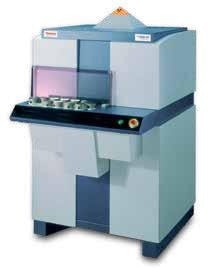
Image Credit: Thermo Fisher Scientific - Elemental and Phase Analysis
The ARL 9900 can identify an extensive number of elements. The instrument’s modular construction enables precise customization for specific applications. The instrument can be configured with the following:
- For quick examination, up to 32 fixed monochromators
- Three goniometers can be set to evaluate individual elements (quantitative and standard-less) or scan the X-Ray spectrum for elements in a sample (qualitative and semi-quantitative analysis)
- The small integrated X-Ray diffraction system is designed for phase analysis in process control
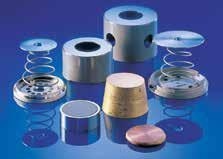
Small and large cassettes can accommodate samples of various sizes. Image Credit: Thermo Fisher Scientific - Elemental and Phase Analysis

Full automation through ARL SMS-2500. Image Credit: Thermo Fisher Scientific - Elemental and Phase Analysis

Large X-Y sample changer. Image Credit: Thermo Fisher Scientific - Elemental and Phase Analysis
ARL 9900 IntelliPower Technical Features
X-Ray System
Created with efficiency and dependability in mind:
- Optical system designed to provide consistent analysis, high sensitivity, and extremely accurate measurement
- An X-Ray tube positioned above the sample shields the device and tube from damage caused by faulty samples, such as metal drill bits or brittle pellets
- Careful and solid construction ensures maximum dependability and longevity in service
- When the X-Ray tube is close to the sample, all elements’ detection limits are lowered and sensitivity is raised. The Rh anode produces effective full-spectrum excitation without affecting the most prevalent elements.
An extra thin Be window (50 microns) enables the optimal radiation transmission efficiency for light element excitation. LoVap technology ensures exceptional long-term analytical stability by preventing any W coating of the window’s inside face.
- Analyses are conducted inside a vacuum chamber with a single cover. As a result, there are fewer vacuum seals and a lower chance of leaks.
- Controlled vacuum pressure and constant temperature management ensures outstanding short- and long-term stability.
Power Supply: A Choice to Suit Any Applications
Instruments from the ARL 9900 Series can be chosen with an integrated high-frequency solid-state generator of medium or high power to best fit each application.
- There is no need for an external water chiller because 1500 W or 2500 W power supply have their own separate circuit for cooling.
- A 4200 W power supply for applications requiring great performance and low detection limits. The maximum output of the conventional generator is 60 kV/70 mA or 35 kV/120 mA
Sample Introduction: Several Degrees of Automation
- The sample introduction mechanism is fast, simple, and highly reliable, with a 12-position sample changer
- The large X-Y magazine enables the automatic handling of a larger series of samples. The X-Y magazine includes 98 coded places for samples in cassettes or on specified supports.
Coding each location enables unsupervised operation and saves time in identifying which samples correspond to a certain analysis. This larger magazine can easily replace the standard 12-position system if needed.
- One sample form, such as pressed powders in steel rings, can be connected to transport belts using an X-Y sample changer version. The name of this basic automation is ARL SMS-XY.
- ARL SMS-2300, SMS-2500, and SMS-3500 robotic systems are optional and provide completely automated sample preparation and introduction for a variety of sample formats
- The instrument can automatically perform unattended continuous process monitoring and sound an alert if any anomalies are found with the SMS settings. The whole sample preparation and analysis process is connected by the versatile and extremely potent ARL SMS-2300 and SMS2500 instruments.
The latest automation innovation is the ARL SMS-3500 series, which uses a quicker and bigger robot to serve an XRF instrument in addition to an OES
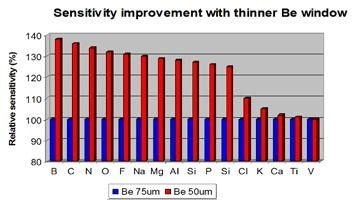
Image Credit: Thermo Fisher Scientific - Elemental and Phase Analysis
Full Microprocessor Control
Putting the Emphasis on Reliability and Ease of Use
The ARL 9900 has full digital control, making it simple to operate. It also guarantees consistent outcomes across a variety of procedures.
The microprocessor architecture consists of clusters of microprocessors, microcontrollers, and digital signal processors coupled with full duplex links. They oversee the instrument’s functioning, monitor hundreds of status points every several seconds, and manage the goniometers, integrated diffraction system, and monochromators.
The OXSAS analytical software transmits instructions to the master microprocessor, sending them to the appropriate cluster. The analytical results are presented on the screen.
Fixed Monochromators
High-Speed Simultaneous Analysis
Fixed channels, all devoted to identifying and analyzing a single element, provide quick analysis, high sensitivity, and quick processing. Up to 32 monochromators for simultaneous analysis, or 24 of them when adding a goniometer, are available for the ARL 9900 series.
The sensitivity and spectral background levels are optimized by compact slit-crystal geometry, allowing for the identification of components at extremely low concentrations. The most recent detectors guarantee a far more accurate analysis and broader linearity of response. All elements from Na do not require detector gas in a simultaneous arrangement.
With temperature regulation to within ± 0.1 ºC, every monochromator is equipped with a mechanism that guarantees exceptional stability in analysis. The examination of light elements is performed using multilayer synthetic crystals. The software is entirely configured to adjust deadtime correction, high voltage, and pulse height discrimination.
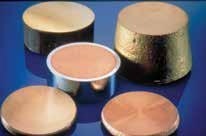
Image Credit: Thermo Fisher Scientific - Elemental and Phase Analysis
Goniometers
Very Precise Sequential Analysis
The goniometers can be set up to carry out quantitative analysis on specific elements or qualitative analysis, which involves scanning the X-Ray spectrum to find elements in a given sample. For ARL 9900 series instruments, two extremely quick and precise gearless goniometers support qualitative, quantitative, and standard-less analysis.
Elements from F to Am can be analyzed with the Thermo Scientific SmartGonio. Three crystals and two detectors are used in this tiny goniometer to provide a flexible and reasonably priced detecting system. The device can hold up to three SmartGonio.
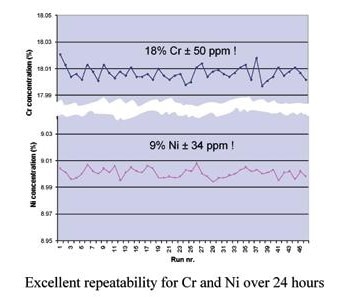
Excellent repeatability over 24 hours, here for Cr and Ni in steel. Image Credit: Thermo Fisher Scientific - Elemental and Phase Analysis
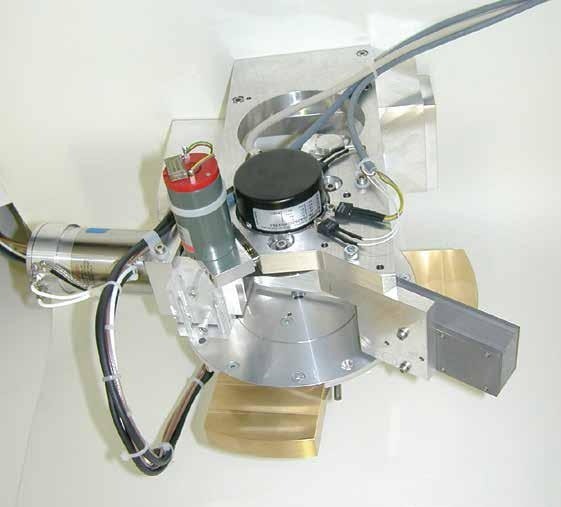
The compact SmartGonio covers F to Am. Image Credit: Thermo Fisher Scientific - Elemental and Phase Analysis
The F45 universal goniometer is the alternative when extra crystals and collimators are required for specific applications. It is possible to fit up to two universal goniometers.
Microprocessors utilizing Moiré fringe technology enable both goniometers to position the crystal and detector quickly and precisely, resulting in high-quality sequential X-Ray spectroscopy. This design has several significant benefits.
- Fast positioning: A slewing speed of up to 4800° 2 theta per minute is up to 20 times quicker than a scanner and five times faster than a traditional goniometer
- Automatic alignment of the theta/2theta angular relationship between crystal and detector: Unlike traditional systems, the microprocessor performs this alignment electronically, so no mechanical modifications are required
- Rapid qualitative analysis: Up to 1200o/min can be achieved in ultra-fast spectra acquisition by continuous digital scanning. Peak recognition occurs automatically.
- No wear, no performance degradation: These “no wear” systems ensure exceptional angular repeatability (< ± 0.0002°) and accuracy (0.001°) consistently since there are no gears to cause friction
- High accuracy of peak positions (e.g. 0.01° with LiF crystal): Analytical peaks are located precisely at their theoretical places, outperforming traditional systems by up to 10 times
- Two detectors can be installed side by side due to independent crystal and detector rotation. Secondary collimators in front of detectors optimize count rate and resolution
- Up to nine different crystals can be mounted on the universal goniometer when unique crystals are needed for specialized applications. This enables the analyst to select the ideal crystal for each section of the X-Ray spectrum. To maximize resolution or intensity, a maximum of four main collimators (fine, medium, coarse, and extra coarse) are available
Full functionality for the study of non-routine items is provided by both goniometers. When combined with the proper software packages (such as Thermo Scientific™ QuantAS or UniQuant™ software) they can allow standard-less analysis and backup for any of the fixed channels.
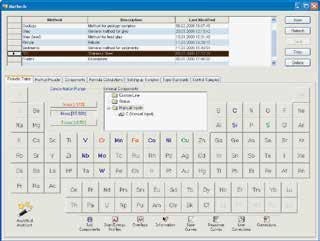
Analytical Assistant helps definition of analytical programs, calibrations and instrument use. Image Credit: Thermo Fisher Scientific - Elemental and Phase Analysis

The 5th generation Moiré fringe universal goniometer. Image Credit: Thermo Fisher Scientific - Elemental and Phase Analysis

Goniometer principle of operation. Image Credit: Thermo Fisher Scientific - Elemental and Phase Analysis
- Moiré fringe optical encoders are used to establish angular positioning that ensures the θ/2θ connection between the crystal and detector:
- No wear
- No friction
- Exceptional precision in angular placement
- Crystal temperature regulation to achieve optimal analytical stability
Two Techniques Integrated in a Single Instrument
XRF and XRD Capability in One Instrument
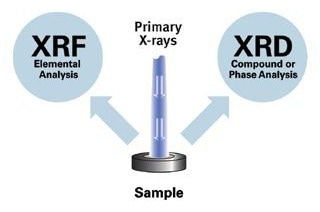
Integration of XRF and XRD in the same instrument: one sample, one instrument, one analysis for two techniques. Image Credit: Thermo Fisher Scientific - Elemental and Phase Analysis
While X-Ray fluorescence (XRF) examination can establish a sample’s elemental makeup, it does not reveal how the elements are combined. Mineralogical information can only be obtained using X-Ray diffraction (XRD).
For instance, XRF can identify the total Ca or total Fe content in a typical crystalline sample. The phases or compounds in crystalline materials, such as rocks, minerals, oxide materials, and products, can be analyzed using XRD.
Thus, XRD advances the analysis in the same sample by providing details on the contents of CaO, CaCO3, Ca(OH)2, and other Ca phases, as well as the levels of Fe phases, including FeO, Fe2 O3, Fe3 O4, Fe3 C, and other Fe phases. As a result, integrating the findings from both XRF and XRD methods enables a more thorough and accurate evaluation of each particular crystalline sample.
Historically, doing both kinds of analysis has required two different X-Ray machines, which would require continuous maintenance and operation at a high expense to the user. However, the combination of cutting-edge X-Ray diffraction systems enables the inclusion of both methods in a single ARL 9900 instrument, offering the user several benefits, such as:
- Only one sample introduction
- Single user interface for both techniques
- Combined elemental and phase data into a single analysis bulletin
- Minimized floor space
- No water cooler at mid power levels
Compact Integrated XRD Systems
Productive, Precise
The Moiré fringe positioning mechanism in the tiny integrated XRD equipment allows for precise qualitative and quantitative scans. Using accurate sample location and parallel beam X-Ray geometry eliminates sample alignment issues.
Working in a vacuum and steady temperature environment improves analytical sensitivity and reproducibility, especially for sensitive phases, such as free lime. Examples of commonly documented uses include:
- Iron phases in DRI (Direct Reduced Iron) processes
- Phases related to the electrolysis of aluminum
- Other mineral and mining applications
- Amorphous content in GBFS and slag cement
- Free lime in clinker and in slags
- Clinker phases (C3S, C2S, C3A andC4AF) for which the ClinkerQuant calibration is available
- Fe2+ determination in sinters
Free Lime-Quartz-Limestone Channel is the name of a specialized variant of the small Integrated XRD system. The same functionality is offered for a fraction of the cost, and the free lime determination in clinker and slags, limestone additions in cement, hot meal calcination monitoring, and quartz content in raw meals are all possible.
Automated Options
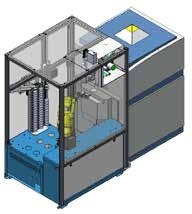
Full automation through ARL SMS-2300. Image Credit: Thermo Fisher Scientific - Elemental and Phase Analysis
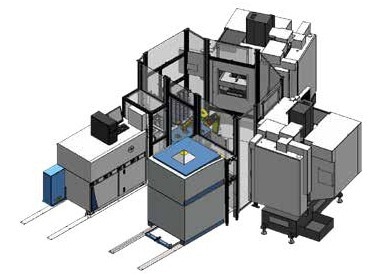
Full automation through ARL SMS-3500 linking ARL iSpark and ARL 9900. Image Credit: Thermo Fisher Scientific - Elemental and Phase Analysis
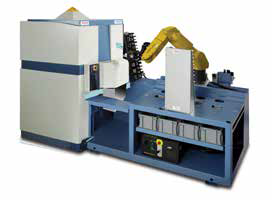
Full automation through ARL SMS-2500. Image Credit: Thermo Fisher Scientific - Elemental and Phase Analysis

Full automation through ARL SMS-XY. Image Credit: Thermo Fisher Scientific - Elemental and Phase Analysis
Software
Reliable Analysis Made Easy
Modern OXSAS software allows for the quick operation of the ARL 9900 and the quick processing of data to provide highly accurate analytical results. OXSAS is a cutting-edge software platform made to adapt to changing demands and provide customers with the most recent solutions for as long as the instrument is in use. With Windows® 10, it runs an operating system.
Its main characteristics and advantages are as follows:
- Featuring cutting-edge software and a contemporary GUI
- Complete and extremely rich capabilities
- The software is mature and has many useful features
- Easy to use, regardless of needs. All tasks, from simple to complicated, can be defined and completed promptly
- OXSAS enables quick and high-quality analysis using template-driven operations
- Simple definition and operation of sample batches. Priority samples were supported. Makes unattended analysis convenient
- The Integrated Analytical Assistant helps create or extend techniques with optimal analytical parameters for faster and more accurate results
- Calibration features include multiple analyte curve displays, quick base curve computation, and templates for editing and measuring calibration standards
- To determine the calibration curve, use multi-variable regression with several correction models and calculate integrated theoretical alphas
- Multi-variable regression with a variety of correction models and integrated theoretical alphas analysis are used to determine the calibration curve
- Scan results are shown as flexible using a graphical user interface
- Multifunctional analysis displays a wide range of optional data; for example, the analysis calculation phases provide method validation
- Online processing functions are highly customizable and can be used manually or automatically
- Results are post-processed and sent to Excel (*.xls file format)
- Real on-line integrated Statistical Process Control (SPC)
- SCT Manager gives an overview of the analytical capabilities of the instrument and each method at any given moment by providing the status and history of Setting-up Samples, Control samples, and Type standards
- Easy to use: Create a batch with only one click, containing all samples for analysis
- Use effective monitoring and maintenance technologies to increase system uptime
- Comprehensive contextual assistance, including “How-To” manuals
- Integrated relational database powered by Microsoft® SQL Server Express that houses all setup and analysis results
- Combines the results of the XRF and XRD studies into a single one
Additional OXSAS software options are:
- SPC-full: On-line Statistical Process Control, full graphical package extension
- ARLcom: Software program for transmitting results via network and serial connection
- Network: Results can be transmitted across a local network to computer programs or files using TCP/IP protocols
- Series: Solutions for transmitting results to computers, printers, or terminals over RS-232 serial line
- OEM Mode: Connect to an external process computer for automation applications
- Layerquant determines the thickness of multilayer coatings
Quantitative Analysis
Accuracy Made Easy
The online Analytical Assistant is used to define analytical programs and calibrations. Utilizing the multi-variable regression (MVR) tool, calibration curves are constructed.
Correction models are employed to reduce the impact of interfering components in multicomponent matrices and improve analysis accuracy. These models are:
- Line overlap correction
- Additive correction on intensities
- Additive correction on concentrations
- Multiplicative correction on intensities
- Multiplicative correction on concentrations
- Multiplicative and additive corrections on concentrations
- COmprehensive LAchance (COLA), which can simulate analytical calibrations for homogeneous materials, with three term alphas to be utilized with the NBSGSC fundamental parameters software. Theoretical alphas, or inter-element correction factors, are computed and utilized as established coefficients in the MVR. This increases analytical accuracy and reduces the number of standards required to generate calibrations.

Statistical Process Control - Typical screen. Image Credit: Thermo Fisher Scientific - Elemental and Phase Analysis
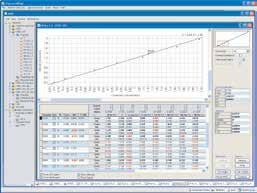
MVR calibration curve: real concentrations vs. intensities. Image Credit: Thermo Fisher Scientific - Elemental and Phase Analysis
Total Elemental Analysis
Two standard-less analytical packages are offered as an option:
- QuantAS software automatically scans up to 70 components from F to U using the F45 universal goniometer
- Semi-quantitative analysis can be completed within 3 minutes
- This tool automates smoothing, background removal, peak identification, overlap and matrix corrections, computation of semi-quantitative concentrations, and normalization for quick and easy analysis of unknown materials.
- UniQuant software yields standardless findings in 4–14 minutes, depending on the number of items evaluated and counting time. It can be installed on both the F45 universal goniometer and the SmartGonio. The longer counting duration per element (2 to 20 seconds or more) makes it the preferred choice for applications requiring high precision and detection of low-concentration levels.
- Standard-free analysis for up to 79 components when particular standards are unavailable. Ideal for obtaining samples
- In small quantities
- In irregular shapes
- As monolayer coatings
- Calculate the balance of unanalyzed elements in the sample, including organic and ultra-light elements.
QuantAS and UniQuant packages have been thoroughly calibrated and installed in the factory. The instruments are ready for use immediately after commissioning. Stable samples for setup and long-term maintenance are given.
Turnkey Calibrations
Ex-works calibrations can be provided for numerous materials, including:
- Clinker phases (C3S, C2S, C3A and C4AF)
- Iron ores according to ISO 9516
- Titanium alloys
- Tin and zinc low alloys
- Ferro-alloys and others for which analytical specifications are available on request
- Cement and clinkers
- Iron, steels and slags
- Copper, bronzes and brasses
- Aluminum and alloys
- Nickel, stellites, and super-alloys
- Various oxides through the General Oxide calibration
- Traces in soils and sediments
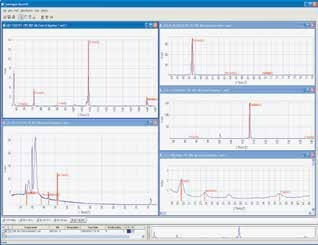
Example of QuantAS scans from which concentrations for the various elements in the sample are derived. Image Credit: Thermo Fisher Scientific - Elemental and Phase Analysis
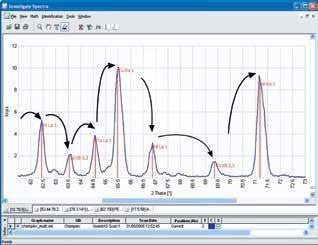
UniQuant uses "peak hopping" to acquire intensities for up to 122 line and background positions. Image Credit: Thermo Fisher Scientific - Elemental and Phase Analysis
Customer Support
The Backing of a Major International Corporation
The company provides users with global support.
- The application product teams can recommend the best ARL 9900 for a specific application and assist with specification development
- Dedicated training enables operators to fully utilize their ARL 9900
- The ARL 9900’s reliable and durable construction is supported by a global aftersales service network that addresses regular inquiries
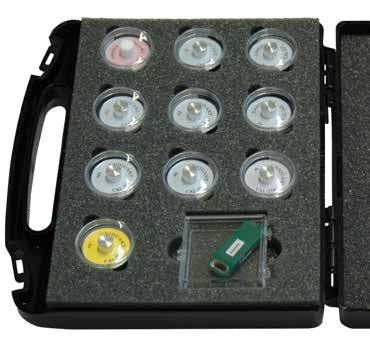
Image Credit: Thermo Fisher Scientific - Elemental and Phase Analysis
General Specifications for ARL 9900 Intellipower
Elemental Range
On a universal goniometer, boron (Nr. 5) to americium (Nr. 95), provided that all required crystals are installed. SmartGonio: Oxygen (Nr. 8) to Amerium (Nr. 95)
Spectrometer Environment
Stabilized vacuum using molecular pump
Spectrometer Design
Analysis instruments housed in a temperature-controlled, grey cast iron vacuum chamber. Temperature regulation via a system of differential heating and cooling. At ± 0.1 °C, the crystals were controlled.
Spectrometer Arrangement
X-Ray tube is positioned vertically at 90° above the sample surface. Analytical instruments are positioned on a 360° ring, gazing down at the sample surface.
X-Ray Tube
The latest generation of high-performance Rh anode end window tubes. The tiny Be window (0.05 mm) improves sensitivity to light elements. LoVap technology provides outstanding long-term stability. Optional W and Mo anodes.
Monochromators
Fixed mechanical systems employ curved crystal optics (flat for light elements) and flow proportional, sealed, or scintillation detectors. Each monochromator has a temperature control of ±0.1 °C. Absorbing filters can be used for extremely high counts. Dual pulse height integration can identify and adjust for second-order peaks.
Universal Goniometer
A gearless, microprocessor-controlled goniometer with optical encoders. Fully automated programming for up to nine flat crystals.
- Up to nine flat crystals
- Up to four primary collimators: fine, medium, coarse, extra-coarse
- Two detectors: scintillation and flow proportional (Ar/CH4 10 %: ultra-low flow 3 ml/min)
- Independent rotation of crystals and detectors
- Maximum slewing speed: 4800° 2θ/min
- Accuracy of peak positions vs. ASTM table on LiF crystals: 0.015°
- Angular reproducibility < ± 0.0002°
- Angular resolution 0.001°
- Total angle range: 0°–153° 2θ (Flow proportional counter: 17°–153°. Scintillation counter: 0°-115°)
- Continuous digital scans: from 0.25°/min to 1200°/min as function of measuring time and increment
- Step scan range: Minimum step: 0.001°
- Maximum practical: 1.00°
- Time of measurement for each step:0.1 s–655 s
SmartGonio
Gearless small goniometer with optical encoders and microprocessor control. Completely autonomous programming of:
- Three flat crystals
- Two detectors: scintillation and flow proportional (Ar/CH4 10 %: ultra-low flow 3 ml/min)
- Fixed collimator selected according to customer’s application
- Independent rotation of crystals and detectors
- Maximum slewing speed: 5500° 2θ/min
- Accuracy of peak positions vs. ASTM table on LiF crystals: 0.015°
- Angular reproducibility: < ± 0.0002°
- Angular resolution: 0.001°
- Total angle range: 0°–150° 2θ (Flow proportional counter: 17°–150°. Scintillation counter: 0°–90°)
- Continuous digital scans: from 0.25°/min to 1200°/min as function of measuring time and increment
- Step scan range: Minimum step: 0.001°
- Maximum practical: 1.00°
- Time of measurement for each step: 0.1 s–655 s
Free Lime-Quartz-Limestone Channel
Compact X-Ray diffraction system with microprocessor control for determining free lime in clinker and slags, adding limestone to cement, tracking the calcination of hot meals, and quartz in raw meal.
Compact XRD System
Compact X-Ray diffraction equipment with microprocessor control for determining phase composition in various processes monitoring.
Counting Electronics
- Multichannel analyzer for better peak discrimination
- Digital Automatic Gain Control (AGC) is utilized to compensate for pulse shrinkage. Linearity of response is guaranteed up to two Mcps on flow proportional counters, 1.5 Mcps on scintillation counters, and 1 Mcps on sealed detectors, thanks to automatic dead time correction
Sample Changer and Cassettes
Basic magazine: 12 cassettes for samples of max. height 40 mm and diameter 60 mm.
Large capacity X-Y changer: 98 cassettes for samples of max. height 30 mm and diameter 52 mm or 98 samples on supports for direct introduction. Exposed opening 29 mm diameter (basic). Rotation of cassettes in analysis position: 60 rpm. Large changer is easily retrofittable.
Primary Beam Filter
Programmable primary beam filter with up to four positions for X-Ray excitation
- Cu: For analysis of Ru, Rh, Pd, Ag, and Cd (elements that are interfered by Rh lines from the X-Ray tube) in light and variable matrices
- Al: To improve peak to background ratio on Pb or As in light matrices
- Others filters on request
Laboratory Information
- Internet connection
- Electrical safety: IEC 61010 – 1
- Radiation safety: fully protected system-interlock system complying with ISO 13489-1
- Electromagnetic compatibility: EN 61326-1 (group 1, class a, industrial)
Particular Specifications for ARL 9900 IntelliPower 1500
Spectrometer Capacity
- 12 fixed channels or
- One goniometer + eight fixed channels or
- One goniometer + one compact XRD system + eight fixed channels
X-Ray generator for 1500 W
- Solid state 1.5 kW high-frequency generator of maximum voltage 60 kV and maximum current 70 mA
- All kV/mA combinations must be chosen to be less than 1500 W.
- Maximum line voltage variation -15 % to +10 %. Stability ± 0.0001 % per 1 % variation
Power Requirements
- 3.8 kVA single phase for 1500 W
Cooling System
- Closed circuit for deionized water flowing through liquid/air heat exchanger
- Flow regulated between 0.5 and 5 lt/min according to generator setting (to keep X-Ray tube temperature constant)
Dimensions and Weight for 1500 W
- H 166 cm, D 136.5 cm, W 93 cm with basic sample changer + H 47 cm, L 83.5 cm, W 41 cm. Weight: 785 kg
Particular Specifications for ARL 9900 IntelliPower 2500
Spectrometer Capacity
- 12 fixed channels or
- One goniometer + eight fixed channels or
- One goniometer + one compact XRD system + eight fixed channels
X-Ray Generator for 2500 W
- Solid state 2.5 kW high-frequency generator of maximum voltage 60 kV and maximum current 100 mA
- All kV/mA combinations must be chosen to be less than 2500 W
- Maximum line voltage variation -15 % to +10 %. Stability ± 0.0001 % per 1 % variation
Power Requirements
- 5 kVA single phase for 2500 W
Cooling System
- Closed circuit for deionized water flowing through liquid/air heat exchanger
- Flow regulated between 0.5 and 5 lt/min according to generator setting (to keep X-Ray tube temperature constant)
Dimensions and weight for 2500 W
- H 166 cm, D 136.5 cm, W 93 cm with basic sample changer + H 47 cm, L 83.5 cm, W 41 cm. Weight: 785 kg
Particular Specifications for ARL 9900 IntelliPower 4200
Spectrometer Capacity
- 32 fixed channels or
- One goniometer + 24 fixed channels or
- One goniometer + one compact XRD system + 14 fixed channels
- Up to three goniometers configurations also available
X-Ray Generator for 4200 W
- Solid state 4.2 kW high frequency generator (max. settings: 60 kV–70 mA or 35 kV–120 mA).
- All combinations must be chosen to be less than 4200 W
- Maximum line voltage variation -15 % to +10 %
- Stability ± 0.0001 % per 1 % variation
Power Requirements
- 7 kVA single phase for 4200 W
Cooling System
- Built-in closed circuit for deionized water flowing through liquid/liquid heat exchanger
- External water needed is <18°C, pressure ≥ 2 bar, flow is regulated between 0.5 and 4.5 lt/min according to generator setting (water consumption minimization)
Dimensions and weight for 4200 W
- H 166 cm, D 136.5 cm, W 93 cm with basic sample changer. Weight: 750 kg